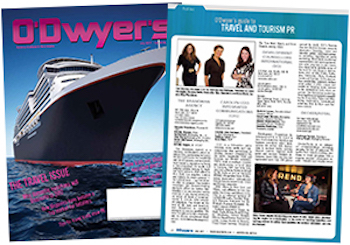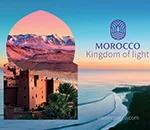|
|
Travelers aren’t simply reading travel guides anymore. In the last decade, consumers have transitioned to TripAdvisor, Google, Yelp, online forums and social media in a bid to crowd-source information, recommendations, visuals and make more purchasing decisions.
The media landscape has undoubtedly changed, and our definition of media has greatly evolved. Where most people used to get their news through the television or newspapers, today, micro-media organisms are popping up on an almost daily basis. Podcasts, mommy blogs, social media influencers and news outlets like NowThis, which use social media platforms to distribute news, have changed the game for public relations and for consumers.
|
|
These new media organisms create enhanced opportunities for brand exposure, widening the realm of public relations’ creative capabilities to reach new yet relevant audiences. In the past few years, publishing houses have amplified digital content with dedicated video production studios, audience engagement editors, renewed websites and podcasts to keep up with emerging digital media trends.
It’s a new world of media, which represents cultural shifts in how people consume and engage with content, and it presents brands with greater opportunities to reach targeted audiences, as long as they can keep up with the deluge of compelling content that cuts through the clutter.
According to Pew Research, 62 percent of Americans now get their news from social media. Combine that with the fact that the average consumer now spends at least five hours a day on his/her smartphone. Yet, as the time we dedicate to the smallest screens expands, many consumers’ attention spans are shrinking, challenging brands to make impact in less time and where it matters most.
Our agency takes a magnifying glass to our clients’ existing and desired audiences to really understand where these potential customers are engaging. We also use a deep-dive technique to identify similar brands which help bolster our clients’ stories, and media exposure, through immersive partnerships and collaborations.
While we know that 57 percent of Americans still get news through television, we’re also aware of the “Netflix population” (those using streaming services over cable subscriptions), which continues to grow. Therefore, our media strategy must incorporate creative ideas that break through to the various platforms where we know our identified target consumers are watching, reading and listening.
New media verticals outside of the yesteryear traditional print and broadcast only mean more opportunity and creative bandwidth for public relations, which ultimately now encompasses greater capabilities and wide-ranging services.
While online media can seem like a repository of sharable listicles and images, we cannot overlook the fact that these forums are grabbing attention and fostering authentic engagement. From a public relations perspective, we’ve found that we can be a dependable resource for digital editors, working hand-in-hand with them and our clients to create meaningful stories — whether it’s through image slideshows, videos, infographics, etc.
We also cannot ignore influencers, though we must study them more closely to understand the level of engagement as well as the psychographics of their followers. New services such as HYPR are emerging to help debunk the data to carefully select the most powerful collaborators and potential brand ambassadors through an assessment of reach, resonance and aesthetic.
What we’re really excited about is turning the right knobs on media and digital to provide strong results for our clients. Humanizing a brand is much of what public relations does, by bringing personalities and experiences to media and finding the right outlets for them to express themselves. While some see public relations professionals as liaisons between editors and clients, we think of ourselves as part of the creative process, the media researchers that unearth how people are interacting with brands. Once we’ve articulated the target demographics, that’s when the fun part starts.
The (r)evolution of the media landscape will continue to grow public relations’ opportunity to modernize their approach to communication, integrating the diverse and emerging platforms to ultimately achieve one goal for clients: find the places where your brand matters most and where we can amplify your exposure with an eager and engaged audience.
Our main focus is to creatively bring stories and experiences to life through any channel that can create conversion and affect the bottom line. Our boundaries and limits have been tested and we’re embracing this new era where we can dive into our clients’ collective objectives and make a difference through curated storytelling that materializes online or in print, on television or radio, podcasts or online video, or through social media. Today, all media channels matter, and we have to assert ourselves with integrated solutions to evolve with the media trends.
***
Jennifer Hawkins is CEO and Founder of Hawkins International Public Relations.

 Jennifer Hawkins
Jennifer Hawkins

 Weber Shandwick is providing PR and marketing communications services to the Moroccan National Tourist Office in New York.
Weber Shandwick is providing PR and marketing communications services to the Moroccan National Tourist Office in New York. Finn Partners has filed its six-month contract with the Bahamas Ministry of Tourism, Investments & Aviation, which is worth $240K.
Finn Partners has filed its six-month contract with the Bahamas Ministry of Tourism, Investments & Aviation, which is worth $240K. Weber Shandwick wrapped up its work for the Ministry of Bahamas at the end of 2023.
Weber Shandwick wrapped up its work for the Ministry of Bahamas at the end of 2023. The Aruba Tourism Authority is boosting its budget 29.4 percent to $2.2M at Zeno Group, according to its 2024 contract, effective Jan. 1.
The Aruba Tourism Authority is boosting its budget 29.4 percent to $2.2M at Zeno Group, according to its 2024 contract, effective Jan. 1. As inflation continues to impact spending, consumers are revisiting their list of what they’re willing to spend more of their money on. Luckily for those in the travel industry, experiences seem to be trending up on the “splurge” list.
As inflation continues to impact spending, consumers are revisiting their list of what they’re willing to spend more of their money on. Luckily for those in the travel industry, experiences seem to be trending up on the “splurge” list. 


 Have a comment? Send it to
Have a comment? Send it to 
No comments have been submitted for this story yet.